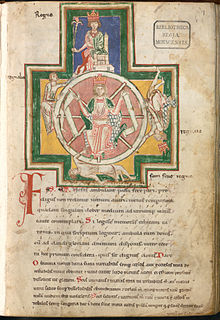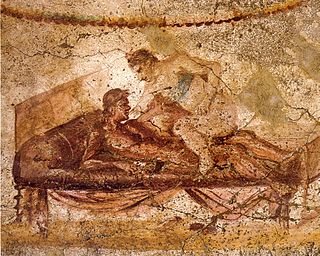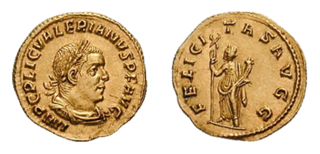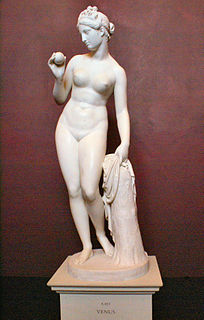In ancient Roman religion, Fortuna Virilis was an aspect or manifestation of the goddess Fortuna who despite her name (virilis, "virile, manly") was cultivated by women only. She shared a festival day with Venus Verticordia on April 1 (Kalendae Aprilis), which first appears with the name Veneralia in the mid-4th century AD. [1]

Fortuna was the goddess of fortune and the personification of luck in Roman religion. Fortuna is often depicted with a gubernaculum, a ball or Rota Fortunae and a cornucopia. She might bring good or bad luck: she could be represented as veiled and blind, as in modern depictions of Lady Justice, except that Fortuna does not hold a balance. Fortuna came to represent life's capriciousness. She was also a goddess of fate: as Atrox Fortuna, she claimed the young lives of the princeps Augustus' grandsons Gaius and Lucius, prospective heirs to the Empire.

Festivals in ancient Rome were a very important part of Roman religious life during both the Republican and Imperial eras, and one of the primary features of the Roman calendar. Feriae were either public (publicae) or private (privatae). State holidays were celebrated by the Roman people and received public funding. Games (ludi), such as the Ludi Apollinares, were not technically feriae, but the days on which they were celebrated were dies festi, holidays in the modern sense of days off work. Although feriae were paid for by the state, ludi were often funded by wealthy individuals. Feriae privatae were holidays celebrated in honor of private individuals or by families. This article deals only with public holidays, including rites celebrated by the state priests of Rome at temples, as well as celebrations by neighborhoods, families, and friends held simultaneously throughout Rome Feriae were of four kinds:

Venus Verticordia was an epithet of the Roman goddess Venus, alluding to the goddess' ability to change hearts from lust to chastity.
According to the poet Ovid, Fortuna Virilis had the power to conceal the physical imperfections of women from the eyes of men. [2] During the Veneralia, she receives an offering of incense, while the more elaborate ceremonies are devoted to Venus. A note from Verrius Flaccus in the fragmentary calendar known as the Fasti Praenestini has been interpreted to mean that respectable women of the upper classes (honestiores) observed the Veneralia separately from those of lesser rank or dubious reputation (humiliores and prostitutes).

Publius Ovidius Naso, known as Ovid in the English-speaking world, was a Roman poet who lived during the reign of Augustus. He was a contemporary of the older Virgil and Horace, with whom he is often ranked as one of the three canonical poets of Latin literature. The Imperial scholar Quintilian considered him the last of the Latin love elegists. He enjoyed enormous popularity, but, in one of the mysteries of literary history, was sent by Augustus into exile in a remote province on the Black Sea, where he remained until his death. Ovid himself attributes his exile to carmen et error, "a poem and a mistake", but his discretion in discussing the causes has resulted in much speculation among scholars.
Marcus Verrius Flaccus was a Roman grammarian and teacher who flourished under Augustus and Tiberius.

Prostitution in ancient Rome was legal and licensed. In ancient Rome, even Roman men of the highest social status were free to engage prostitutes of either sex without incurring moral disapproval, as long as they demonstrated self-control and moderation in the frequency and enjoyment of sex. At the same time, the prostitutes themselves were considered shameful: most were either slaves or former slaves, or if free by birth relegated to the infames, people utterly lacking in social standing and deprived of most protections accorded to citizens under Roman law, a status they shared with actors and gladiators, all of whom, however, exerted sexual allure. Some large brothels in the 4th century, when Rome was becoming officially Christianized, seem to have been counted as tourist attractions and were possibly state-owned.
Plutarch is the only source to mention the Temple of Fortuna Virilis, which he says was founded by Servius Tullius. [3] Because of her association with Venus Verticordia, Fortuna Virilis may likewise have had her temple in the Vallis Murcia. A temple in the Forum Boarium sometimes identified as that of Fortuna Virilis is more likely to belong to Portunus, [4] though possibly it was built for Portunus and rededicated to Fortuna Virilis. [5] In the early Middle Ages it was converted to a church perhaps called Santa Maria de Secundicerio. [6]

Plutarch, later named, upon becoming a Roman citizen, Lucius Mestrius Plutarchus, was a Greek biographer and essayist, known primarily for his Parallel Lives and Moralia. He is classified as a Middle Platonist. Plutarch's surviving works were written in Greek, but intended for both Greek and Roman readers.

Servius Tullius was the legendary sixth king of Rome, and the second of its Etruscan dynasty. He reigned 575–535 BC. Roman and Greek sources describe his servile origins and later marriage to a daughter of Lucius Tarquinius Priscus, Rome's first Etruscan king, who was assassinated in 579 BC. Servius is said to have been the first Roman king to accede without election by the Senate, having gained the throne by popular support; and the first to be elected by the Senate alone, without reference to the people.

The Forum Boarium was the cattle forum venalium of Ancient Rome. It was located on a level piece of land near the Tiber between the Capitoline, the Palatine and Aventine hills. As the site of the original docks of Rome, the Forum Boarium experienced intense commercial activity.









